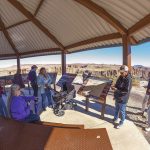
After leaving Times, Tome founds rival paper
Marshall Tome made the front page of the Navajo Times again 50 years ago when he was appointed head of the poverty program under the Office of Navajo Economic Opportunity.
Tome was the first editor of the Navajo Times and served in that position for almost three years before stepping down after a dispute with Navajo Tribal Chairman Raymond Nakai over news coverage.
For a time there, he seemed to be considered a supporter of Nakai but after stepping down from his position at the tribal newspaper, his support eventually went to Peter MacDonald, who was then head of ONEO.
After MacDonald became chairman, Tome became one of his top go-to guys and advisers. He was one of the few people in the administration who socialized with MacDonald. Tome was especially appreciated for his vast understanding of chapter politics, which became especially valuable during elections.
The interesting thing about Tome occurred after MacDonald left office in 1983.
Tome, upset at the way MacDonald was portrayed by the Navajo Times and the local off-reservation press, created his own monthly newspaper, the Navajo Nation Enquiry, which published stories that reflected his admiration for what MacDonald had accomplished.
The paper was generally well received and while it is doubtful Tome made much money from it, he was happy with it. It ran as an alternative to the Navajo Times, publishing mostly positive stories, for more than two years.
In other news, the Peace Corps celebrated its fifth year sending volunteers to the reservation.
Dr. Bennie C. Williams, director of the agency’s Libya Program at the University of Utah, said it was “one of the finest programs the Peace Corps had in teaching English as a foreign language.”
The agency sent 80 volunteers a year to the reservation, training them at 30 reservation schools, most of them operated by the BIA.
The volunteers were immersed in the Navajo culture, often staying with a Navajo family and getting involved in all aspects of the community’s life. They were often invited to attend some Navajo ceremonies.
Nakai was a big supporter of the program, often speaking of them highly at chapter meetings and urging communities to make the best use of them while they were there.
Most of the volunteers, at least in the beginning, were female and were allowed by the program to make any arrangements they wanted as far as living quarters.
That changed a little after the second year when a female volunteer was raped. She lived alone and after that, the agency required female volunteers to live with another female volunteer for protection.
There was a concern after the incident by some tribal officials who worried that the agency would cut back on the number of volunteers or even stop sending volunteers altogether, but the program on the reservation was too important to the agency to do that.
There were few places in the United States where they could send a large group of volunteers to immerse themselves in a totally unique culture. Volunteers were encouraged to learn the Navajo language while they were here.
Tome, while editor of the Times, praised volunteers for their efforts to learn the language and while it is doubtful that any became fluent, most came away knowing how to handle themselves in simple conversation.
Speaking of MacDonald, he spoke at a student assembly this week 50 years ago at Navajo Community College where students asked him about the possibility of the reservation getting statehood.
After all, at 16 million acres, the reservation was bigger in size than the smallest five states in the union. Statehood would make sense in that regard.
But MacDonald pointed out that the population was only about 100,000 and that would be a major obstacle that could not be overcome.
Another major problem to becoming a state, said MacDonald, centered on economics.
As long as reservation residents had to go off-reservation to buy their goods, the reservation would be too isolated to get any consideration as a possible state.
While statehood, which would come up again every few years, was probably out of the question, having the reservation designated as a congressional district was not.
Studies by the tribe showed that a congressional district, including a couple of border communities, could be feasible and would guarantee the election of a Navajo to Congress.
The problem was that no border community would accept being in a congressional district where Navajos held the majority for fear of being shut out of federal funding.








 Highway 264,
Highway 264, I-40, WB @ Winslow
I-40, WB @ Winslow